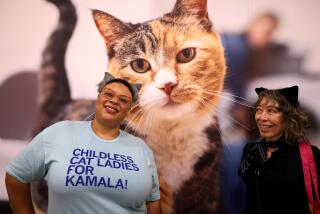Method Meowing
- Share via
Most cat fanciers would agree that television has basically given short shrift to this near purr-fect pet.
Sure, Morris the Cat became a TV commercial icon as the spokes-feline for 9 Lives cat food, but television quite literally has gone to the dogs. Such pooches as Lassie, “Frasier’s” Eddie and Murray from “Mad About You” have gotten all the press and the glory.
But things are changing. Cats are now the No. 1 pet in America, with approximately 60 million kitties, as compared to 55 million dogs. And three popular prime-time series prominently feature felines.
ABC’s “Sabrina, the Teenage Witch,” stars Salem, a wisecracking warlock turned into a black cat for 100 years.
CBS’ “Early Edition” features a mysterious, sweet orange tabby who delivers the next day’s newspaper every morning to Gary (Kyle Chandler).
And cartoonist Caroline Duffy (Lea Thompson) shares her apartment with Salty on NBC’s sitcom, “Caroline in the City.”
Fred Barron, an executive producer of “Caroline,” decided to include a cat in the series after catching an episode of the 1992-93 Bob Newhart sitcom “Bob,” in which his cat bound down the stairs and jumped on the sofa to watch TV with Newhart.
“We had done a dog in ‘Dave’s World,’ ” he says. “I have two cats, as well as two dogs, and they’re great.”
The cat was just a pet in the original concept of “Early Edition,” but when executive producer Bob Brush developed the pilot, the nameless kitty arrived with the newspaper. “It was a great sound for the delivery of the paper,” says executive producer Lillah McCarthy. “We knew the paper arrived because there was the sound of the thud of the paper and a cat’s meow.”
In the case of “Caroline,” Barron says, the producers were looking for a cat with experience and an expressive face to play Salty. They found those qualities in Tiki, a 9-year-old Himalayan. “It is that centeredness we love about her,” says Barron, who adds that the animal is being pursued to be the spokescat for a cat food company.
Trainer Tammy Maples has owned Tiki for seven years. “She was a rescue cat,” Maples says. “She was actually from a kitty mill. When Tiki had a reproductive problem, [the breeder] didn’t want her any more.”
Initially, Tiki was shy and withdrawn, but soon became the mascot at Maples’ company, Jungle Exotics. Her first film experience was playing Sassy in “Homeward Bound: The Incredible Journey.”
Not only can Tiki do stunts on cue, such as eating a pie on the kitchen counter and then stopping to look up at a television set, she has the amazing ability to stay still up to 45 minutes. “She is so into working,” Maples says. “She takes her ‘stays’ very seriously.”
All the trainers encourage the actors who work with the cats to spend time with them. Amy Pietz, who plays Caroline’s saucy friend Annie, loves to hang out with Tiki.
“She is more professional than most actors,” says Pietz, who grew up with cats. “Tiki is a hard worker. She is, like, working with De Niro. She is definitely a more experienced actress than I am in front of the cameras.”
Though a puppet is used for Salem’s talking close-ups on “Sabrina,” four main cats--Elvis, Lucy, Witch and Salem--play the warlock-turned-feline in all the other scenes.
The cats’ trainer, Mark Watters, says it’s really not any more difficult to train a cat than a dog. “Your motivation is different. The dog is the only animal in the world that will do things for you because it loves you. [With cats] we use a little food reward and teach them that working is fun.”
Nick Bakay, a writer on “Sabrina” and the voice of Salem, is amazed at how well Watters has taught the cats. “I have two cats and a dog,” he says. “I know the difference between the dog’s ability to be obedient and the cats’, [who are] are completely aloof.”
Certain cats, too, are more trainable than others. “You can train any of them to do things,” Watters says, “but for them to be able to handle going out and the exposure of the lights--things that are very scary for cats--you need the right personality.”
Panther, a 10-year-old tabby who plays the magical beastie on “Early Edition,” is pretty finicky. But he’ll bound across a crowded room on command for a spoonful of Fancy Feast. “We have him conditioned to run to his little carrier where he gets fed,” says trainer Bill Casey, who has owned the former pound mascot for more than 8 years.
According to Casey, Panther has a wonderful personality. “I have several dogs,” says Casey, who also trains the German shepherd used in the series. “I was so impressed with his confidence. He would walk into a room and would go and lay in the middle [of the dogs] and go to sleep.”
Though he trained Panther, the cat was basically Casey’s house pet. But when Michael Dinner, an executive producer and director of the “Early Edition” pilot, was looking for a star feline for the series, Panther got his big break. Dinner wanted a cat that resembled a big orange tabby he adored named Carl that used to hang out at the 20th Century Fox lot.
As the series has progressed and the cat’s confidence has grown, Panther’s role has expanded. “They’ve made him almost a helper of Kyle’s,” says Casey. “This has involved him going into courtrooms, homes and animal hospitals. He likes it. He’s interested in being nosy and what’s going on around him. It’s actually been positive.”
“Sabrina, the Teenage Witch” airs Fridays at 9 p.m. on ABC; “Early Edition” airs Saturdays at 9 p.m. on CBS; and “Caroline in the City’ airs Tuesdays at 9:30 p.m. on NBC.
More to Read
The complete guide to home viewing
Get Screen Gab for everything about the TV shows and streaming movies everyone’s talking about.
You may occasionally receive promotional content from the Los Angeles Times.







